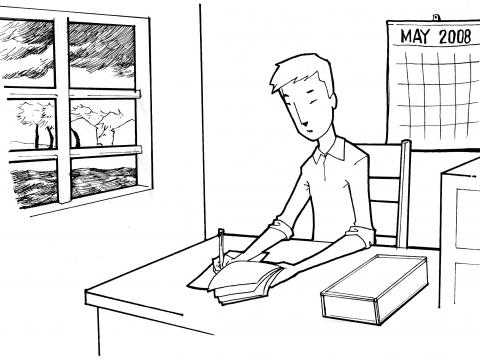Cyclone Nargis- Transforming a nightmare to readiness

By Soe Thiha Shwe, as told to Phoebe Naw, Illustration by James Dimanarig
It was 2 May 2008 just before Cyclone Nargis struck Myanmar. I was doing my normal work routine when I heard the storm warning on the radio that afternoon.
Situated on a riverbank in a delta village where the Ayeyarwady River and a small river meet, the Rural Health Centre where I worked sat still and calm. As a health assistant working for a government department, I had very little knowledge about the approaching storm. Figuring it just an average strong storm, I continued my work and prepared nothing- ignoring the storm warning.
The rising tide increased the water level, reaching up to my chest. We climbed on top of tables, chairs, and patient beds.
The wind was much stronger at 5pm; exceeding the radio warning of 60 mph. Soon enough, outside the health centre it was total darkness. Roofs were flying away and tree branches were breaking. People fled into the health centre to take shelter.
When I peeked out the window using a torch (flashlight), I saw a house, a small shop, and the jetty were all completely flattened.
The rising tide increased the water level, reaching up to my chest (about 4 feet). We climbed on top of tables, chairs, and patient beds. There were 15 of us in the centre, including four children.
Read Part 1 of the Humanitarian illustrated blog series - decreasing disaster impact.
The roof of the health centre started to detach and was soon taken away in the wind.
One of my staff members was crying. She was thinking of her parents still at her home village of Hine Gyi, later found to be one of the worst hit communities.
I too started to worry about my parents. They were in another delta town. I was so worried, but could do nothing. It was a living nightmare. The storm roared furiously the entire night. We all prayed as per our religious beliefs.
The wind finally let up around 4am the next morning.
Our medicines and pharmaceutical materials were soaked and no longer usable. Injured patients started to arrive, but as I had nothing left, I could only give first aid and referred them to the hospital in town.
The next day, I went to town for reporting about the condition of my health centre and the staff working with me. There, I was told that the midwife working under my supervision and her 4-year-old daughter drifted away and disappeared during the storm. Everyday, her husband would sit beside the river looking for his wife and daughter among the drifting dead bodies. It was tragic news.
The horrible smell of death drifted everywhere.
I managed to travel to local villages on a boat damaged by the storm, collecting data. If the boat sank in the river I would die unnoticed, I remember thinking.
I saw the dead bodies of human and animals floating in the river, as the local government officials could not manage to clear it. The horrible smell of death drifted everywhere.
Survivors walked from the village in search of shelter and assistance, as they were hungry and had no place to stay.
I tried to help the survivors with my limited resources.
Even a month later, we had received nothing from our local government departments or other organizations.
I was so angry. The damage was everywhere. People were in despair. Survivors flooded into the camps seeking help.
I felt guilty not being able to help them, so I quit my job.
A month later, I started my new chapter with World Vision Myanmar helping with the emergency response. With full support, I travelled around the delta to provide medical assistance to survivors.
I was so pleased that I could help the affected people.
Currently, I work as a Capacity Building Coordinator, working to mitigate disaster risks. I provide training for staff and communities and run simulation exercises. I also work together with the communities to develop a Disaster Preparedness Plan.
I am so satisfied with the work that I am doing now.
The lack of an effective and reliable early warning system combined with flimsy building construction increased the damage and loss of life. In the aftermath, the immediate response like deploying search and rescue teams, distributing basic needs like food and water, and medical assistance was delayed.
If I could make a recommendation to governments, I would suggest establishing an effective, reliable early warning system and adequate funding for emergency responses. It is also good to have a stand-by emergency team with adequate capacity so that they are ready for an immediate assignment.
My encounter with Nargis is helping me, help communities prepare well for future disasters.
Note: Cyclone Nargis took the lives of about 150,000 people and left tens of thousands of children and families in devastating conditions.